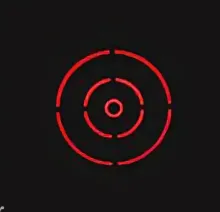
The Telrad Finder is a non-magnifying sighting device used by amateur and professional astronomers alike to locate and center objects in the night sky. Invented by Steve Kufeld in the 1970s, the Telrad Finder has become one of the most popular and widely used finderscopes on telescopes due to its simplicity, accuracy, and ease of use. It projects a series of concentric rings onto a clear window, allowing astronomers to "point and shoot" at celestial objects with remarkable precision.
What is a Telrad Finder?

A Telrad Finder is a reflex sight that uses a glass window and an illuminated reticle to show three concentric rings, representing angular distances of 0.5°, 2°, and 4°. Unlike traditional optical finderscopes, which magnify the field of view, the Telrad Finder superimposes its reticle onto the actual sky. This makes it ideal for star hopping and locating deep-sky objects using star charts.
Features of the Telrad Finder
- Projected Reticle: The Telrad projects three rings onto the sky, with the innermost ring representing a half-degree (ideal for locating planets), the middle ring representing 2 degrees, and the outer ring representing 4 degrees.
- Parallax-Free Viewing: Because the reticle is projected at infinity, it remains centered regardless of the viewing angle, making the Telrad highly accurate and easy to use.
- Adjustable Brightness: The Telrad’s brightness can be adjusted using a knob, ensuring that the reticle remains visible even under varying light conditions.
- Large Viewing Window: The window is large and clear, offering a broad, unobstructed view of the sky.
- No Magnification: Unlike traditional finderscopes, the Telrad Finder does not magnify the sky, making it easier to locate large star patterns and match them to a star chart.
How to Use the Telrad Finder
- Aligning the Telrad: First, attach the Telrad to your telescope using its included base and align it with your telescope’s main optics. This is usually done by centering a bright star in your telescope’s eyepiece and adjusting the Telrad’s screws until the star appears in the center of the Telrad’s rings.
- Finding Celestial Objects: Use the Telrad to superimpose its reticle rings onto your target area in the sky. The different ring diameters correspond to specific angular distances, making it easy to position the telescope precisely.
- Star Hopping: The Telrad is perfect for star hopping, a technique where you move from one recognizable star pattern to another to find less visible objects. By using the concentric rings as a measuring tool, you can easily hop between stars and deep-sky objects.
Benefits of Using a Telrad Finder
- Ease of Use: The Telrad’s design allows for quick and intuitive targeting, making it a perfect accessory for beginners.
- Compatibility: The Telrad Finder can be used on almost any telescope, from small refractors to large Dobsonians.
- Enhances Accuracy: The large field of view and clear rings make it easier to match what you see in the sky to your star chart.
- Useful for Astrophotography: For astrophotographers, the Telrad Finder helps precisely position telescopes for framing objects in the camera’s field of view.
Telrad Accessories
Several accessories can enhance the Telrad’s functionality:
- Dew Shield: Protects the Telrad’s viewing window from dew, which can be a problem during humid nights.
- Telrad Riser: Lifts the Telrad higher off the telescope’s surface, making it easier to view when the telescope is pointed near the zenith.
- Telrad Base: Additional mounting bases allow the Telrad to be quickly moved between multiple telescopes.
- Telrad Charts: Printed or digital charts designed specifically for use with the Telrad’s ring pattern make star hopping even easier.
Pros and Cons of the Telrad Finder
Pros:
- Simplicity: No magnification means no confusion or need for focusing.
- Ease of Alignment: The three rings make it easy to align and center objects.
- Affordable: Compared to optical finderscopes, the Telrad is reasonably priced.
- Wide Field of View: Helps locate large-scale star patterns and move between objects.
Cons:
- Size: The Telrad is larger than some other finders and may be cumbersome on small telescopes.
- Dew Sensitivity: The glass window can fog up in humid conditions.
- No Magnification: While this is also a benefit, the lack of magnification can make it difficult to see faint objects in light-polluted areas.
Comparison with Other Finderscopes
The Telrad Finder is often compared to red dot finders and optical finderscopes. Here’s a brief comparison:
- Telrad vs. Red Dot Finders: Red dot finders are more compact and lighter, but they lack the three-ring reticle, making it harder to gauge distances between stars. The Telrad’s rings offer a more precise reference for star hopping.
- Telrad vs. Optical Finderscopes: Optical finderscopes magnify the image, making it easier to see faint stars. However, they can be harder to use for beginners, as aligning the telescope becomes more challenging due to the narrower field of view.
The Telrad Finder is a versatile, easy-to-use accessory that has earned its place as a favorite among amateur astronomers. Its unique ring system, large field of view, and parallax-free design make it an indispensable tool for star hopping and locating celestial objects. Whether you’re a beginner just learning the night sky or an experienced observer, the Telrad Finder can significantly enhance your telescope’s accuracy and ease of use.
Investing in a Telrad Finder is a great choice if you want to streamline your stargazing experience and spend more time observing and less time searching for objects in the night sky.
